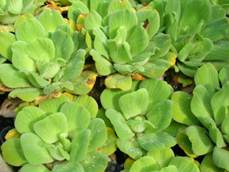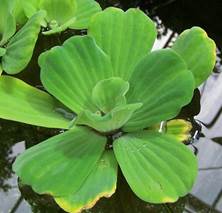| Sahyadri Conservation Series - 61 |
ENVIS Technical Report: 113, August 2016 |
 |
My Village Biodiversity: Documentation of Western Ghats
Biodiversity through Network of Students and Teachers
| 
|
| T.V. Ramachandra* |
M D Subash Chandran |
Bharath Settur. |
Deepthi Hebbale |
Prakash Mesta |
Rajasri Ray |
Sudarshan P. Bhat |
Asulabha K S |
| Sincy Varghese |
Durga Madhab Mahapatra |
Harish R. Bhat |
Vinay S. |
Vishnu D. Mukri |
Gouri Kulkarni |
Bharath H. Aithal |
The Ministry of Science and Technology, Government of India,
The Ministry of Environment, Forests & Climate Change, Government of India
Indian Institute of Science, Bangalore 560012,
*Corresponding author: cestvr@ces.iisc.ac.in,
energy@ces.iisc.ac.in
|
|
SECTION 6 : ECOLOGICAL MONITORING - MACROPHYTES
Aquatic macrophytes refers to aquatic vascular plants and these plant species normally found growing in wetlands, either in or on the water, or where soils are flooded or saturated long enough for anaerobic conditions to develop in the root zone are called as macrophytes (Cowardin et.al 1979). The aquatic macrophytes occur mainly in the shallow region of lakes ponds, pools, marshes streams and rivers etc. These are grouped into three categories based on their habit as:
- Submerged macrophytes: Largely or completely submerged plants, the roots may or may not be present (Ceratophyllum, Hydrilla, vallisneria etc)
- Emergent macrophytes: Plants not submerged in water, further subdivided into two (a) erect leaved emergent plants: rooted plants with principle photosynthetic surfaces projecting above the water (Typha, Scirpus etc) (b) floating leaved emergent plants: rooted plants with floating leaves (Nymphaea, Nelumbos etc)
- Floating macrophytes: plant floating on the water surface (Eichhornia, Lemna, Pista etc)
Macrophytes are of considerable ecological and economic importance. They contribute significantly to the productivity of water bodies; mobilize mineral elements from the bottom sediments and provide shelter to aquatic macroinvertibrates and fishes. They also respond to changes in water quality and have been used as indicators of pollution. When there is enough room for colonization and abundant availability of nutrients, macrophytes show a high growth rate. They assimilate nutrients directly into their tissues. Due to these they were used to solve eutrophic problems of freshwater bodies and to remove pollutants.
- Sampling: The sampling of macrophyte depends on type of habit, type of vegetation, variation and distribution of the vegetation and aim of the study. It is essential to first survey the area and decide about the suitable sampling methods. Quadrat method of sampling is followed (50 cmX50cm or 1mX1m for emergent).
- Vegetation mapping: This is done 1)to calculate total macrophytic biomass of different species in a water body 2) to understand the distribution pattern of vegetation 3) to monitor the changes caused by a pollutant on these patterns at various times.
- Treatment of samples: Immediately after collection wash the plants to remove adhered soil, epiphytes etc. Drain out the excess water after washing. Take the fresh weight of sample. Transport the samples to the lab in polythene bags.
- Biomass estimation: After determining fresh weight of the samples, keep the samples in hot air oven at 105°C for 24 hrs for the determination of dry weight. Biomass is usually estimated as dry matter per unit area.
12.0 ECOLOGICAL MONITORING - MACROPHYTES
Aquatic macrophytes is a term given to a vast category of aquatic vascular plants. Plant species normally found growing in wetlands, either in or on the water, or where soils are flooded or saturated long enough for anaerobic conditions to develop in the root zone are called as macrophytes (Cowardin et.al 1979). The aquatic macrophytes occur mainly in the shallow region of lakes ponds, pools, marshes streams and rivers etc. They belong to following 3 categories on the basis of their habit:
- Submerged macrophytes: Largely or completely submerged plants, the roots may or may not be present (Ceratophyllum, Hydrilla, vallisneria etc)
- Emergent macrophytes: Plants not submerged in water, further subdivided into two (a) erect leaved emergent plants: rooted plants with principle photosynthetic surfaces projecting above the water (Typha, Scirpus etc) (b) floating leaved emergent plants: rooted plants with floating leaves (Nymphaea, Nelumbos etc)
- Floating macrophytes: Entire plant will be floating on the water surface (Eichhornia, Lemna, Pista etc)
Macrophytes are of considerable ecological and economic importance. They contribute significantly to the productivity of water bodies; mobilize mineral elements from the bottom sediments and provide shelter to aquatic macroinvertibrates and fishes. They also respond to changes in water quality and have been used as indicators of pollution. When there is enough room for colonization and abundant availability of nutrients, macrophytes show a high growth rate. They assimilate nutrients directly into their tissues. Due to these they were used to solve eutrophic problems of freshwater bodies and to remove pollutants.
Sampling: The sampling of macrophyte depends on type of habit, type of vegetation, variation and distribution of the vegetation and aim of the study. It is essential to first survey the area and decide about the suitable sampling methods. Quadrat method of sampling is followed (50 cmX50cm or 1mX1m for emergent).
Vegetation mapping: This is done 1)to calculate total macrophytic biomass of different species in a water body 2) to understand the distribution pattern of vegetation 3) to monitor the changes caused by a pollutant on these patterns at various times.
Treatment of samples: Immediately after collection wash the plants to remove adhered soil, epiphytes etc. Drain out the excess water after washing. Take the fresh weight of sample. Transport the samples to the lab in polythene bags.
Biomass estimation: After determining fresh weight of the samples, keep the samples in hot air oven at 105°C for 24 hrs for the determination of dry weight. Biomass is usually estimated as dry matter per unit area.
COMMON MACROPHYTES IN WETLANDS OF INDIA
Name:Eichhornia crassipes
Common Name: Water hyacinth
Description: Water hyacinth is a free-floating perennial aquatic plant, With broad, thick, glossy, ovate leaves; leaves are 30-40 cm long with spongy petiole. Roots are fibrous and featherlike.
Flowering: March-July
Habitat: Water hyacinth grows in still or slow-flowing fresh water in tropical and temperate climates. Optimum growth occurs at temperatures of between 28°C and 30°C, and requires abundant nitrogen, phosphorus and potassium.
Impact: Its wide spread occurrence in the fresh water lakes and riverbeds is harmful to fishing (depleting DO), rowing, and depleting water content from the water bodies and interfering in water utilization and other activities. Water hyacinth by its abundance of leaves, dense vegetation and innumerable rootlets in tertiary manner obstruct water flow in irrigation channels and displaces many aquatic grasses, which were useful as fodder for cattle, and suppresses the phytoplankton growth. Water hyacinth provides suitable breeding places for mosquitoes and other disease-carrying insects by stagnating the water in ditches and shallow areas.
Uses: Phytoremediation, waste water treatment |
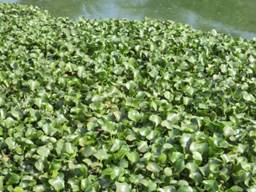
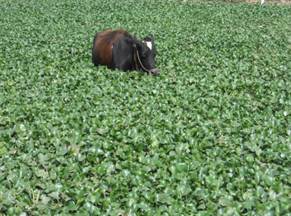
|
Name: Alternanthera philoxeroides
Common name: Alligator weed
Habitat: grow in a variety of habitats, including dry land but usually found in water.
Stems are pinkish, long, branched, and hollow. Fleshy, succulent stems can grow horizontally and float on the surface of the water, forming rafts, or form matted clumps which grow onto banks
Leaves are simple, elliptic, and have smooth margins. They are opposite in pairs or whorls, with a distinctive midrib, and range in size from 5-10 cm.
Flowers: whitish, papery ball-shaped flowers that grow on stalks.
Fibrous roots arising at the stem nodes may hang free in water or penetrate into the sediment/soil.
Flowering: December-April
Impact: Alligator weed disrupts the aquatic environment by blanketing the surface and impeding the penetration of light. Such blanketing can also prevent gaseous exchange (sometimes leading to anaerobic conditions) which adversely affects aquatic flora and fauna. It also competes with and displaces native flora along river and in wetlands. |
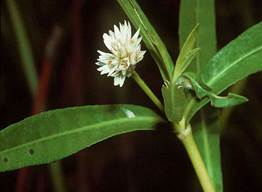
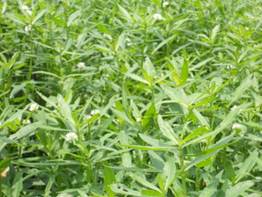
|
Name: Typha
Common name: Cattail
Description: It is a common perennial marsh, Aquatic or wetland plant in temperate, tropical, and subtropical climates. Plants are rhizomatous monoecious herb, grow upto 1.5-3m high, Leaves radical, sheath white. Flowering stem length is typically equal to or somewhat longer than leaf length. Numerous tiny, dense, flowers occur in a terminal spike that is 0.7 to 2 inches, Male flowers make up the upper, narrower half of the spike and female flowers the lower, slightly wider half
Flowering: June- August
Habitat: It grows in shallow water of lakes, rivers, ponds, marshes, and ditches.
Significance: Phytoremediation, wastewater treatment, Used as medicine, fodder |
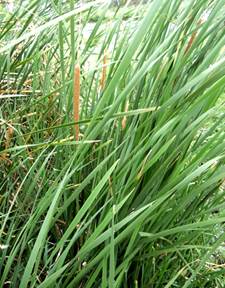
|
Name: Lemna
Common name:Common duckweed
Lemna minor: free-floating aquatic plants, with one, two or three leaves each with a single root hanging in the water; as more leaves grow, the plants divide and become separate individuals. The root is 1-2 cm long. The leaves are oval, 1-8 mm long and 0.6-5 mm broad, light green, with three (rarely five) veins, and small air spaces to assist flotation. It propagates mainly by division, and flowers rarely produced.
Habitat: Grows in water with high nutrient levels and a pH of between 5 and 9, optimally between 6.5 and 7.5, and temperatures between 6 and 33 °C.
Significance: Important food resource for fish and birds(ducks)
|
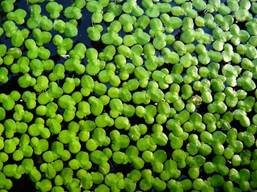
Lemna minor
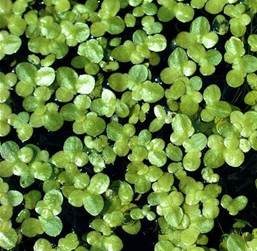
Lemna gibba
|
Name:Pistia stratiotes
Common name: water cabbage, water lettuce
Description: Aquatic free-floating, odorous monoecious herb with thick, soft leaves that form a rosette. Roots hanging submersed beneath floating leaves. Leaves can be up to 14 cm long and have no stem. They are light green, with parallel veins, wavy margins and are covered in short hairs which form basket-like structures which trap air bubbles, increasing the plant's buoyancy.
Habitat: waters with high nutrient content, particularly those that have been contaminated with human loading of sewage or fertilizers
Impact: major weed of lakes, dams, ponds, irrigation channels and slow-moving waterways in tropical, subtropical and warmer temperate regions. It can completely cover water bodies, disrupting (lowering DO) all life on the water. |
|
Name:Polygonum glabrum
Common name: Common Marsh Buckwheat
Morphology: Stems erect, shrubby, upto 2.5 m tall, leaf blades shortly petiolate, blades narrowly lanceolate, glabrous except for midrib and some lateral nerves, flowers in terminal and axillary, 7-10 cm long spike-like racemes
Habitat: Perennial or annual, found along water courses and tanks but is also found in marshes. It is often dominant along large rivers
Significance: Tender branches used as vegetable, also used for dispelling fever and colic. |
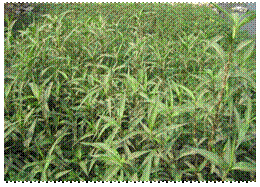
|
Name:Ipomea aquatica
Common name:Water spinach, river spinach
Morphology: Plants aquatic, annual, twining herbs, stem hollow, leaves alternate and entire, flowers solitary or in cymes, corolla pinkish, darker in throat,fruit 4-6 valved capsule.
Habitat: usually floating on stagnant water sometimes found on banks of pools, canals and rivers
Significance: It is often cultivated for its edible shoots and as a medicine. It can be serious weed if left to grow unchecked. |
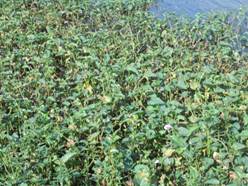 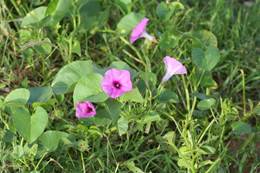
|
Name: Ludwigia
Common name: Water Primrose, Water Dragon, marshy jasmine
Habitat: Still or slow flowing freshwater habitats, occurring in marshes, swamps, ditches, ponds, and around lake margins, where they form dense floating mat. Shallow, nutrient-rich ponds, lakes, and drainage ditches provide ideal conditions for abundant growth of this weed.
Aquatic floating herb, floats crowded at nodes, white
Leaves alternate simple, ovate, obtuse entire
Flowers: Axillary, solitary, peduncle 2.5 cm long, corolla 5, yellow, inserted on the rim of the disc, base narrow.
Flowering: February-July
Harvesting period: August
Impacts: Once established, however, it forms dense, monotypic stands along shorelines and banks |
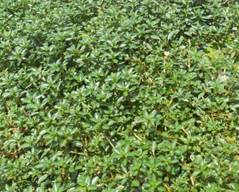
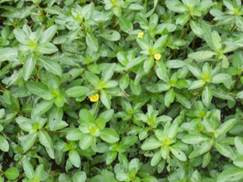
|
Name: Nymphaea
Leaves with a deep sinus, veins mostly radiating from the summit of the petiole and repeatedly forked; flowers born above the water surface. Sepals 4, green or streaked with red. Petals numerous, showy, stamens numerous, with or without appendaged connectivities. Pistil-1, carpels many, syncarpous, ovary superior.
Nymphaea nouchali:
Habitat: Perennial or annual, found in still or flowing water up to 2 m deep, in a wide variety of habitats
Significance: The rhizomes, flower buds and seeds of some species eaten for food, medicine or to cause hallucinations. The rhizomes are used as mordant in dyeing and tanning. Many species and hybrids are cultivated for ornament. |
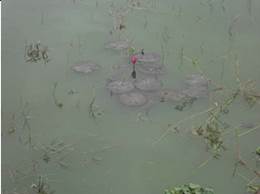
|
Nelumbo: Leaves without sinus, centrally peltate, unarmed, carpels many, free, ovary superior.
Nelumbo nucifera:
Common name: Lotus
Morphology: Large perennial, with milky latex. Stems dimorphic, slender horizontal, vegetative stolons or rhizomes or thickened storage rhizomes. Leaves alternate, petioles upto 3 m or long, bearing numerous spines, leaf blades when immature floating, when mature raised above the water surface, Flowers large (8-20 cm diameter), pink to red or white; petioles and peduncles rough, perianth segments 14-30, stamens upto 200 or more, filaments upto 1 cm anthers upto 1.2 cm long, Carpels 12-30.
Significance: Widely cultivated as a crop for its edible rhizomes, edible nuts and for honey, also grown for ornament, leaves are used for serving food, Sacred for Hindus; buds are collected for worship in temples. It is used in medicine; seeds for skin diseases and diarrhea, rhizomes for piles and ringworm. |
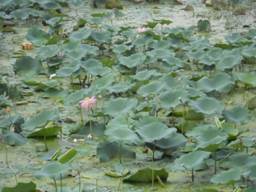
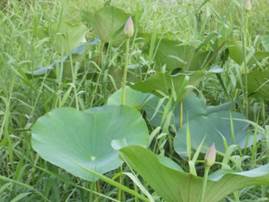
|
Name: Potamogeton
Common Name: Pond weed
Morphology: Stems usually elongate, flexible, submerged or floating or stoloniferous and creeping, leaves submerged or floating, stipulate, sessile or petiolate, distichous, alternate or opposite, flowers small emerged or submerged, tetramerous, in terminal spikes, Perianth of 4, bract like, Stamens 4, united with perianth at base, anthers sessile, Ovary superior, carpels several free, sessile, fruit drupelet
Habitat: Perennial or sometimes annual. Found in a wide variety of aquatic habitats, totally submerged or with floating leaves. Occasionally it grows in brackish water.
Name: Cyperus
It is a perennial plant, which may reach a height of up to 40 cm.
Common name: nut grass, nut sedge
Habitat: Cyperus is found in cultivated fields, farmlands, neglected areas, wastelands, grasslands, at the edges of forests, and on roadsides, sandy or gravelly shores, riverbanks and irrigation canal banks. Grow profusely in nutrient rich environment.
Leaves: Leaves sprout in ranks of three from the base of the plant. The flower stems have a triangular cross-section. The flower is bisexual and has 3 stamina and a three-stigma carpel. The fruit is a three-angled achene.
Rhizome: The root system of a young plant initially forms white, fleshy rhizomes. Some rhizomes grow upward in the soil, then form a bulb-like structure from which new shoots and roots grow, and from the new roots, new rhizomes grow. Other rhizomes grow horizontally or downward, and form dark reddish-brown tubers or chains of tubers.
Impacts/significance: It is a weed and the world's worst invasive weed based on its distribution and effect on crops. It contains several chemical compounds and used in medicines. |
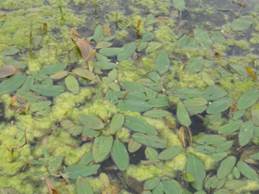
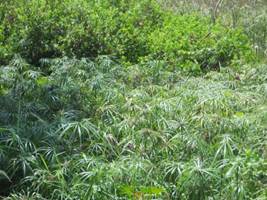
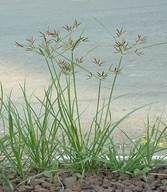
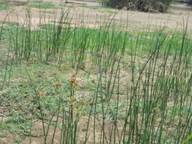
|
Azolla
- Habitat: Annual sometimes perennial in permanent water. Free floating on permanent or temporary water, in rice fields, canals and ponds.
- Used as fertilizer-contains nitrogen fixing cyanobacteria
- Roots simple bearing numerous root hairs, stems alternately branched, branches arranged pinnately or bipinnately, leaves alternate, ovate divided into 2 lobes-upper lobe thick green and usually somewhat reddish, above the water lower lobe 1 cell thick, colorless short in contact with water with cyanobacterium.
- Growth phase : Nov-Feb
|
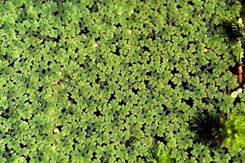
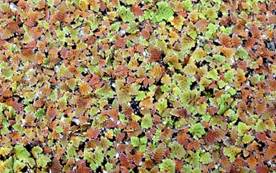
|
Salvinia
- Habitat: Perennial or annual. Free floating mat-building plants. Heterosporous;
- Morphology: Stems floating, irregularly forked, without roots.
- Leaves in whorls of 3, 2 of them floating and 1 submerged, floating leaves photosynthetic, entire with complex unwettable hairs on adaxial (upper) surface and wettable hairs on the abaxial surface; submerged leaves not photosynthetic, finely divided into filamentous segments which bear a striking resemblance to roots.
- Sporocarps born on modified segments of submerged leaves; megasporangial sporocarps developed first, microsporangial sporocarps developed later, producing numerous microsporangia, each containing usually 64 microspores.
- It can be a very serious pest, spreading by vegetative fragments.
|
 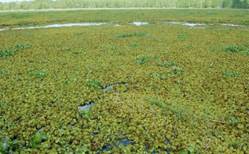
|
Marsilea
- Perennial or annual, found in shallow pools, edge of rivers, canals, lakes and rice fields. Most abundant in temporarily flooded places where it forms dense colonies
- Plants mat forming, rhizomes slender, wiry, repeatedly branched, creeping or floating
- Leaves spirally rolled when young, compound, Leaflets very variable 2-25 mm long, terrestrial leaflets with outer margins entire, bilobed to many lobed, floating leaflets with margins entire.
- Sporangia in closed sporocarps, born on short stalks arising from petioles or in their axils
- Reproductive phase-Nov-Jan
- Used in medicine
|
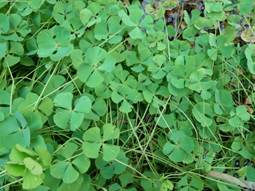
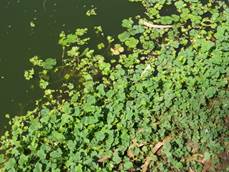
|
Ceratophyllum
- Morphology
- Shoot tips often with shortened internodes giving it bottle brush appearance.
- Leaves usually bright or olive green, rigid
- Perennial or sometimes annual, totally submerged, rootless, free-swimming.
- Sept-Nov
- Ceratophyllum can be used as a measure of lake pollution, as it can contain trace metals such as cadmium and lead in plant tissue (Stankovic et al. 2000)
|
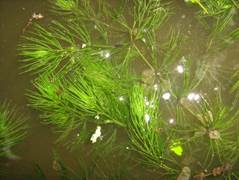
|
Hydrilla
- Habitat: Mostly perennial but sometimes annual
- Totally submerged.
- Growing in still or slowly flowing water
- Oct-March
- Stems elongate, branched regularly but at distant intervals, horizontal and stoloniferous below, erect and spreading above, bulb-like structures develop either underground terminally on stolons or or terminally or axillary on erect stems or their branches.
- The leaves are strap-shaped with pointed tips and saw-tooth edges, Leaf colour can vary from green, translucent, yellowish, to brown
- found in freshwater but can tolerate salinities of up to 7% salinity
|
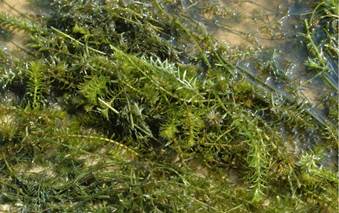
|
«  »
Lake 2016: Conference on Conservation and Sustainable Management of Ecologically Sensitive Regions in Western Ghats


Lake 2016: Conference on Conservation and Sustainable Management of Ecologically Sensitive Regions in Western Ghats
Introduction:Symposium focusing on lakes/wetlands popularly known as “Lake Symposium” was initiated by the Energy & Wetlands Research Group at Centre for Ecological Sciences, Indian Institute of Science, Bangalore in the year 1998. The theme was broadened in 2000 (Lake 2000) with a wider participation of education institutions, Governmental and non-governmental organisations, etc. The basic idea of the symposium was to bring out the trends in ecosystem conservation, restoration and management including the hydrological, bio-physical, people’s participation and the role of non-governmental, educational and the governmental organizations and the future research needs. Lake 2016 will be the 10thBiennial Lake Conference focusing on“Conservation and Sustainable Management of Ecologically Sensitive Regions in Western Ghats”will be held at foothills of Western Ghats. The theme of World Wetlands day 2016is Wetlands for our Future: Sustainable Livelihoods to demonstrate the vital role of wetlands for the future of humanity and specifically their relevance towards achieving the new Sustainable Development Goals. Lake 2016conference provides a unique opportunity to increase understanding of the role ofwetlands in sustaining the food, water and human livelihood with the challenges faced by thesefragile ecosystems.
Wetland ecosystems are cradles of biological diversity, providing water and primary productivity upon which countless species of plants and animals depend for survival. The degradation of these vital ecosystems is linked to continuing problems of land cover changes, deforestation, habitat fragmentation, pollution, indiscriminate disposal of liquid and solid wastes, and issues related to economic productivity and ecological security. The structural changes in the ecosystem due to land cover changes, will influence the functional aspects namely hydrology, bio-geo chemical and nutrient cycle, which are evident in many regions in the form of conversion of perennial streams to seasonal and disappearance of water bodies leading to a serious water crisis. There is growing evidence that biological diversity will be severely threatened by rapid climate change. Also, hydrological changes could be the dominant effect of climate change, as snowmelt increases, as evaporation rates increase and as droughts, storms and floods intensify. Much of the hydrological changes will be reflected in changes in freshwater ecosystems including most of the wetland areas. The biological impacts include dwindling of the biodiversity, habitat damage and loss of spawning grounds of aquatic organisms, reduction in inland fisheries resources and loss of vegetation. Conservation of natural resources through sustainable ecosystem management and development is the key to our secured future. Formulation and implementation of action plans that best conserve wetland resources require an understanding of issues, concerns and threats to water resources. Approaches towards this direction include:
- Fostering participation of all stakeholders to ensure that individuals and organizations are provided an opportunity to participate in the development of aquatic resources conservation activities;
- Encouraging intergovernmental initiatives through partnerships between communities and non-profit organizations;
- Identifying significant natural, recreational, economic, cultural, scenic resources and aquatic ecosystem values;
- Identifying potential threats to aquatic resources and values;
- Recommending policies and actions that can be undertaken to restore, maintain or enhance aquatic and terrestrial resources.
- Recommending policies and action plan towards the conservation and sustainable management of ecologically sensitive regions in Western Ghats – water tower and food bowl for peninsular India.
Scope: Lake 2016– ‘Wetlands for our Future: Sustainable Livelihoods’would demonstrate the vital role of wetlands for the future of humanity and specifically their relevance towards achieving the new Sustainable Development Goals. Lake 2016 conference provides a unique opportunity to increase understanding of the role of wetlands in sustaining the food and water with the challenges faced by these fragile ecosystems. Lake 2016would focus not only on updating of the current knowledge of the scientific community and also would bring in awareness among students, teachers and public. This would provide a platform for interaction among researchers, policy makers, academics and NGOs and address the issues related to wetlands and biodiversity in an era of climate change. This would help in developing a stronger network among experts and institutions in order to develop efficient strategies for the conservation and management of fragile ecosystems. As a part of the conference it has been decided to have theme based lead lectures by the eminent scholars, paper and poster presentations by researchers, school and college students.
Objectives:Focus of Lake 2016 would be (i) assessment of the present status and conservation aspects of wetlands, lakes, tanks, ponds, swamps, streams and rivers in the Western Ghats, (ii) presentation by researchers, practitioners, students of case studies focusing on biodiversity, ecology, present status, threats, conservation measures required, (iii) discussion of current programmes on restoration, conservation and management of wetlands, (iv) role of education institutions, non-governmental organisations, religious organisations, (v) discussion of people’s livelihood and fundamental right towards equitable resource allocation through scientific assessment of ecosystem goods and services, (vi) presentation by students (schools and colleges) based on documentation focusing on wetlands – biodiversity, present status, ecology, conservation and protection needs, (vii) allocation of financial and human resources to conserve and protect ecologically fragile ecosystems, (viii) proposals by students and non-governmental organisations for conservation, protection, restoration and sustainable management of aquatic ecosystems, (ix) discussion on research gaps and activities to be initiated by researchers to evolve appropriate strategies towards conservation of ecosystems in Western Ghats, and (x) developing strategies for conservation and sustainable management of ecologically sensitive regions in Western Ghats to sustain water, food and human livelihood.
THEMES: Papers are invited on the following themes from researchers, planners, development managers, economists and social scientists, school (VIII – XII students) and college students, school and college teachers.
Topics for Paper Presentation/ Poster in Lake 2016:
- Wetlands for future: sustainable livelihood;
- Food and water security, people’s livelihood;
- Climate Change and Ecological Sensitiveness of Western Ghats;
- Biodiversity& Ecology: Western Ghats;
- Wetlands and swamps: Restoration, Conservation and Management;
- Aquatic and Terrestrial Ecosystems: Linkages
- Land use, Land cover dynamics in Western Ghats
- Carrying Capacity of Western Ghats;
- Carrying capacity of river basins in Western Ghats;
- Valuation of Ecosystem Goods and services;
- Sacred Groves (kans, devarakadu) and Myristica Swamps;
- Eco-Tourism in Western Ghats and Carbon sequestration;
- Application of Geoinformatics in Wetland Management;
- Natural and Anthropogenic disasters;
- Limnology, aquatic ecology, biodiversity and prospects of bio-monitoring;
- Pollution –terrestrial and aquatic - Monitoring and Management, bioremediation;
- Sustainable Agriculture and organic farming;
- Coastal ecosystems – Biodiversity, Ecology, Productivity and livelihood aspects;
- Prospects of Renewable Energy (solar, biofuel, bioenergy) and Energy Conservation;
- Environmental Education and Sustainable Development;
- Environment Ethics and Green Technology;
- Environment Literacy.
There are three awards in students and teachers category— High School (VIII, IX, X); College (XI, XII and UG) and Teachers (school and college). Awards for the best paper presentation would include a Certificate and a Memento. The best posters would be similarly, awarded.
ACCOMMODATION:
- Key speakers and invited delegates would be accommodated at Guest house in the college campus.
- Students and teachers would be accommodated at Student’s Hostel on campus
- Delegates whose paper is accepted for technical session will be accommodated at hostel on first come first serve basis.
- Delegates requiring accommodation need to mention the requirement in the registration form. Room rent is required to be paid by the delegates as per the tariff in the respective hotel (Rs. 1000/person/day – non AC room and Rs 1500/person/day for AC room).
Accommodation will be arranged on payment basis upon the request from the delegates.
REGISTRATION FEE
- Delegates*: Rs. 2,500/-, Accompanying person: Rs. 1500/-
- Research scholars and University faculty*: Rs.2000/-
- Masters students*: INR 1000/- (mandatory to attend all three days)
- UG students*: INR 500/- (mandatory to attend all three days)
- Representatives* from NGO: Rs. 5,000/ -, Industry:10.000/-, Govt Agency: 5,000/-
- School and College students: Free. The organizing committee has decided to waive registration fee to school students and school teachers whose papers are accepted for presentation in the technical session.
Demand draft be drawn in Favour of the “Lake 2016, Alva’s College, Moodbidri, Dakshina Kannada. DD to be sent along with duly filled in registration form.
*Mandatory to attend all the 4 days to get the conference certificate.
The registration fee would include registration kit, working lunch and tea during the symposium. Accompanying person will have access to all technical sessions and hospitality as per delegates except registration kit.
EXHIBITION STALL:
An exhibition of software and hardware related to Restoration and Monitoring technologies, Water quality analysis, Geographic Information System (GIS), Global Positioning System (GPS), Remote sensing, Image processing and Cartography, as well as products and services of other organizations and agencies working in the area related to the theme of the conference, will be organised. Organisations / Agencies can participate in the exhibition on payment of fee of INR 25,000. Registered agencies would be allowed to make 10 minutes presentation. Interested agencies may contact the working President, Lake 2016 and remit the fee through DD drawn in favor of "Lake 2016, Alva’s College" payable at Moodbidri.
Lake 2016 SPONSORSHIP DETAILS:
Lake 2016 welcomes the support through sponsorship. Logo & Name of Sponsors will be displayed appropriately in Backdrop, Stands &Souvenir of Lake 2016. Sponsors will be given adequate mileage thru coverage. |
Category of Sponsor Fee |
Complementary delegates & stall |
Diamond Sponsor |
Rs. 5,00,000/- |
(4 delegates, 12sqm exhibition stall) |
Gold Sponsor |
Rs. 2,50,000/- |
(4 delegates, 6 sqm exhibition stall) |
Silver Sponsor |
Rs. 1,50,000/- |
( 2 delegates, 4 sq m exhibition stall) ) |
|
Demand draft be drawn in favourof “Lake 2016, Alva’s College, Moodbidri, Dakshina Kannada. DD to be sent along with duly filled in registration form.



The paper title, name(s) of author(s), affiliation and address, center justified, should be typed in a space of 50 mm from the top margin on the first page. The paper should begin with a synopsis of not more than 200 words describing the aim(s) of the work, methods, results obtained and conclusions. Type the headings, subheadings and paragraphs aligned with the left-hand margin (Align Left). Text justified on both sides is preferred. Use double space between paragraphs, and between section headings/subheadings and paragraphs. Do not number paragraphs, but number section and sub-sectional headings except synopsis, in conformity with established convention. The manuscript should be prepared by using MS Word (suitable for Windows). Figures should be drawn in black Indian Ink on translucent paper or acetate material (Gateway Tissue) with lettering of appropriate size using stencils. The figures should be placed nearest to the first reference in the text. Photographs on glossy paper may be included, if absolutely necessary. The authors must send brief bio-data (100 words) and the recommendations that they would like to be considered as a part of the conference based on their presentations.
Posters: Size A 0 and template as per
http://wgbis.ces.iisc.ac.in/energy/lake2014/posters/poster_shrikant.pdf

Dates to Remember
Registration [Registration form]. |
15th September 2016 |
Submission of scientific papers (full length / extended abstract), posters with the Registration Form (with the registration fee, depending on the category) – delegates presenting papers/posters. |
15th September 2016 |
Review of Papers and posters by the committee |
30thSeptember 2016 |
Final submission of the revised manuscript (based on review) |
30th October 2016 |
Notification of Acceptance of Papers (on web) |
15th November 2016 |
Lake 2016 Conference |
28-30th December 2016 |
Field work |
31st December 2016 |
Paper Acceptance details at: http://ces.iisc.ac.in/energy


Place:___________Date:___________
Organisation
Energy & Wetlands Research Group, CES, Indian Institute of Science, Bengaluru
The Energy and Wetlands Research Group at the Centre for Ecological Sciences (CES), is actively involved in studies and training on issues related to environment, water resources, energy, ecology, wetlands, geographic information systems, environmental impact assessment and natural resource management. The Centre for Ecological Sciences, founded in 1983 with the support of Ministry of Environment and Forests offers exciting opportunities for research in a variety of areas in ecology. Over the past 25 years, and more, CES have instilled a tradition of rigorous enquiry in diverse areas of ecology, evolution and behavior. The projects of CES are often integrative which uses multiple approaches, from theoretical and laboratory studies to field-based research, to explore the research questions. A number of CES research areas are breaking new ground in ecology while others have significant roles in conservation. Details at http://ces.iisc.ac.in/energy
https://www.researchgate.net/profile/T_V_Ramachandra/publications
Indian Institute of Science (http://www.iisc.ac.in)
The Indian Institute of Science (IISc) was founded in 1909 as a result of the joint efforts of Jamsetji Nusserwanji Tata, the Government of India, and the Maharaja of Mysore. In 1886, Jamsetji Tata conceived of a university of science that will work for the benefit of India, and in 1898 created an endowment for establishing such an institution.
Over the 105 years since its establishment, IISc has become the premier institute for advanced scientific and technological research and education in India. Beginning with 2 departments and 21 students in 1911, today IISc has 39 departments, units, or centres, 3500 students, and about 500 academic and scientific staff, supported by 600 administrative personnel. Out of this population of students, about 2200 are in various PhD programs, almost 900 are enrolled for various Masters degrees, whereas about 400 are registered in the newly established, research oriented, four-year Bachelor of Science (Research) programme, of which the first batch graduated in 2015.
Alva’s Education Foundation ( R ) Moodbidri (http://alvas.org/)
Alva’s Education Foundation ( R ) Moodbidri, was established in 1995 by visionary chairman Dr. M. Mohan Alva to provide the quality education to the rural students mainly in and around Moodbidri. He has succeeded in developing Moodbidri as education hub in South Canara with 20 various Educational Institutions. These educational Institutions are characterized by quality education across a broad range of disciplines in the field of Medicine and Allied health Sciences, Arts, commerce, Business & Management, Basic Sciences, Engineering & Technology, Social Science, Education, Physical Education, Pre University Courses and Primary Education. The Foundation also organizes many cultural and literary events like “Alva’s Virasath” and Alva’s Nudisiri” and festivals of all communities to infuse rich meaning in to the contemporary social life which is otherwise fraught with modern monotony and mundane fullness. Alva’s Pragati is a mega job fair which provides job to job seeker across the state and have provided more than 25,000 jobs since the inception.
Address for Communication
Dr. Kurian
Working President, Lake 2016
Principal, Alva’s College
Vidyagiri, Moodbidri, Dakshina Kannada – 574227
Moodbidri, Karnataka, India,
Phone: 08258-250275, 236531,
08258- 250200 to 207,
Cellphone: +919740668967
Fax: 08258-237341,
principal@alvascollege.com
http://alvascollege.com/upcoming-events/lake2016 |
Dr. T.V. Ramachandra
Chairman, Lake 2016
Energy and Wetlands Research Group, TE 15,
Centre for Ecological Sciences
Third Floor, E wing, New Bioscience Building
[Near D Gate], Indian Institute of Science,
Bangalore 560012
Phone: 91-080-22933099/2293 3503 (extn. 101/107)
Email:cestvr@ces.iisc.ac.in, lake2016@ces.iisc.ac.in
Lake2016symposium@gmail.com
Conference
Web: http://ces.iisc.ac.in/energy |

Citation: Ramachandra T V, Subash Chandran M D, Bharath Settur, Deepthi Hebbale, Prakash Mesta, Rajasri Ray, Sudarshan P. Bhat, Asulabha K S, Sincy Varghese, Durga Madhab Mahapatra, Harish R. Bhat, Vinay S,. Vishnu D Mukri,,Gouri Kulkarni, Bharath H. Aithal, 2016. My Village Biodiversity: Documentation of Western Ghats Biodiversity through Network of Students and Teachers, Sahyadri Conservation Series 61, ENVIS Technical Report 113, Environmental Information System, CES, Indian Institute of Science, Bangalore 560012
| | | |









